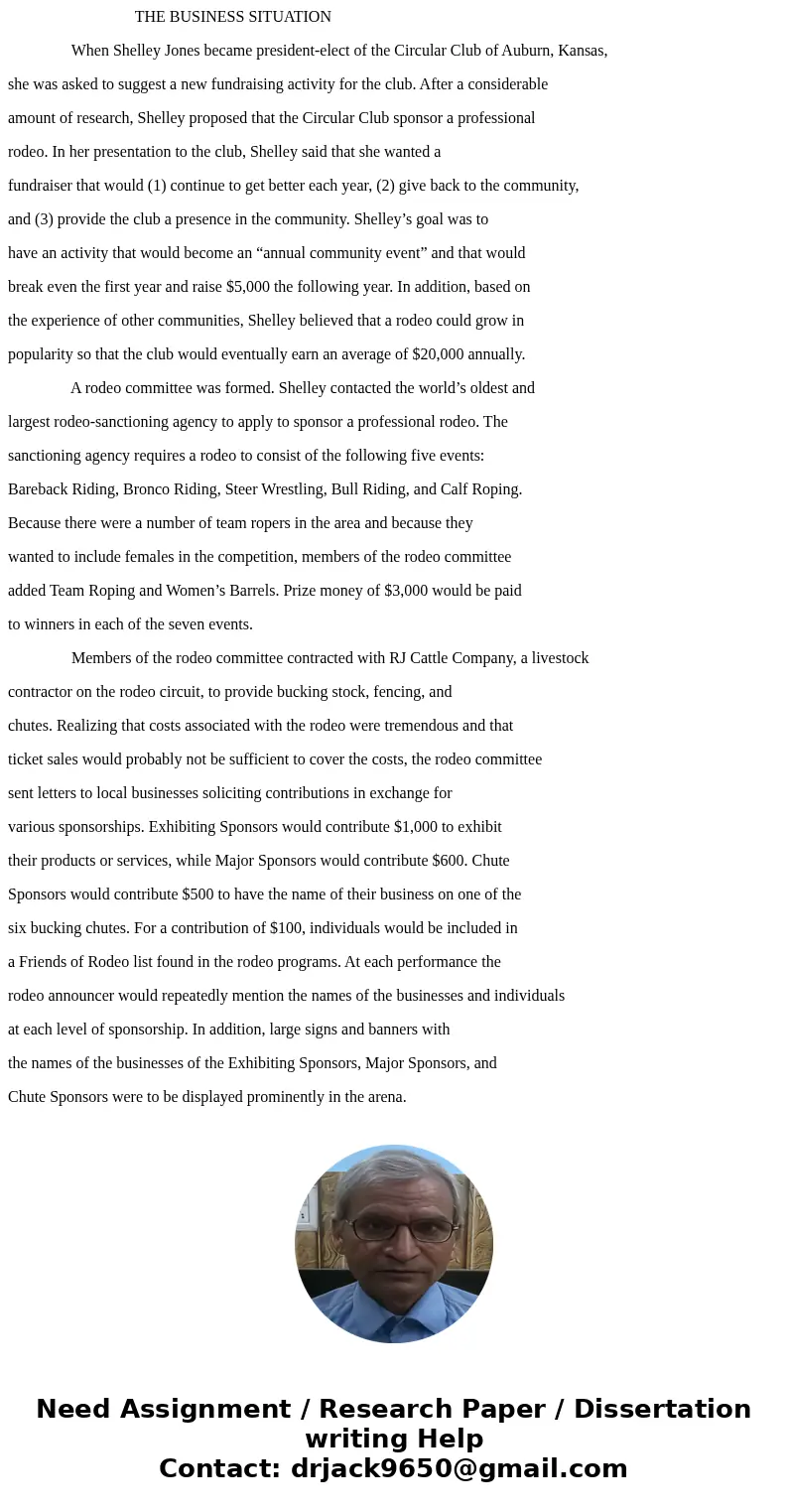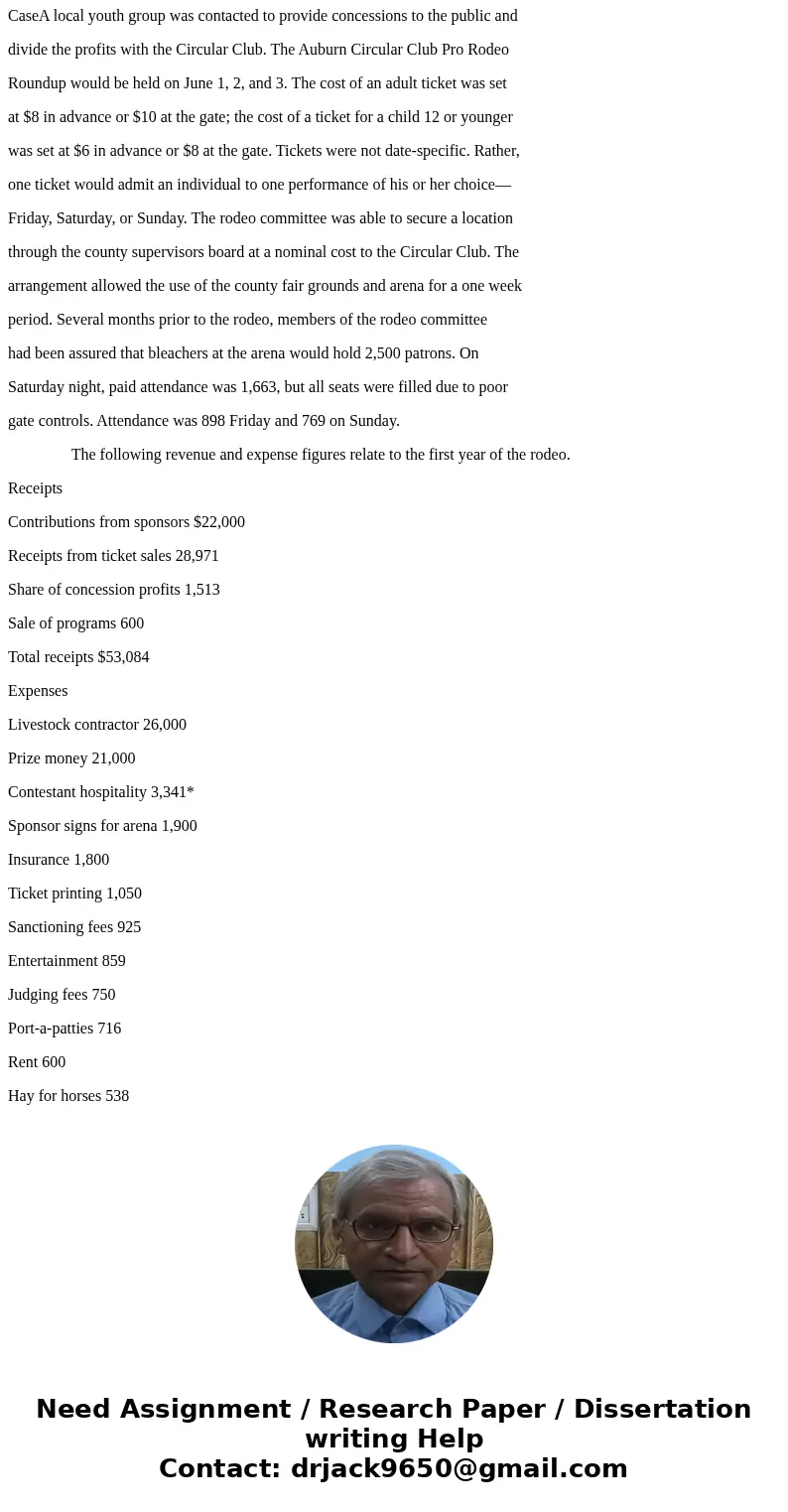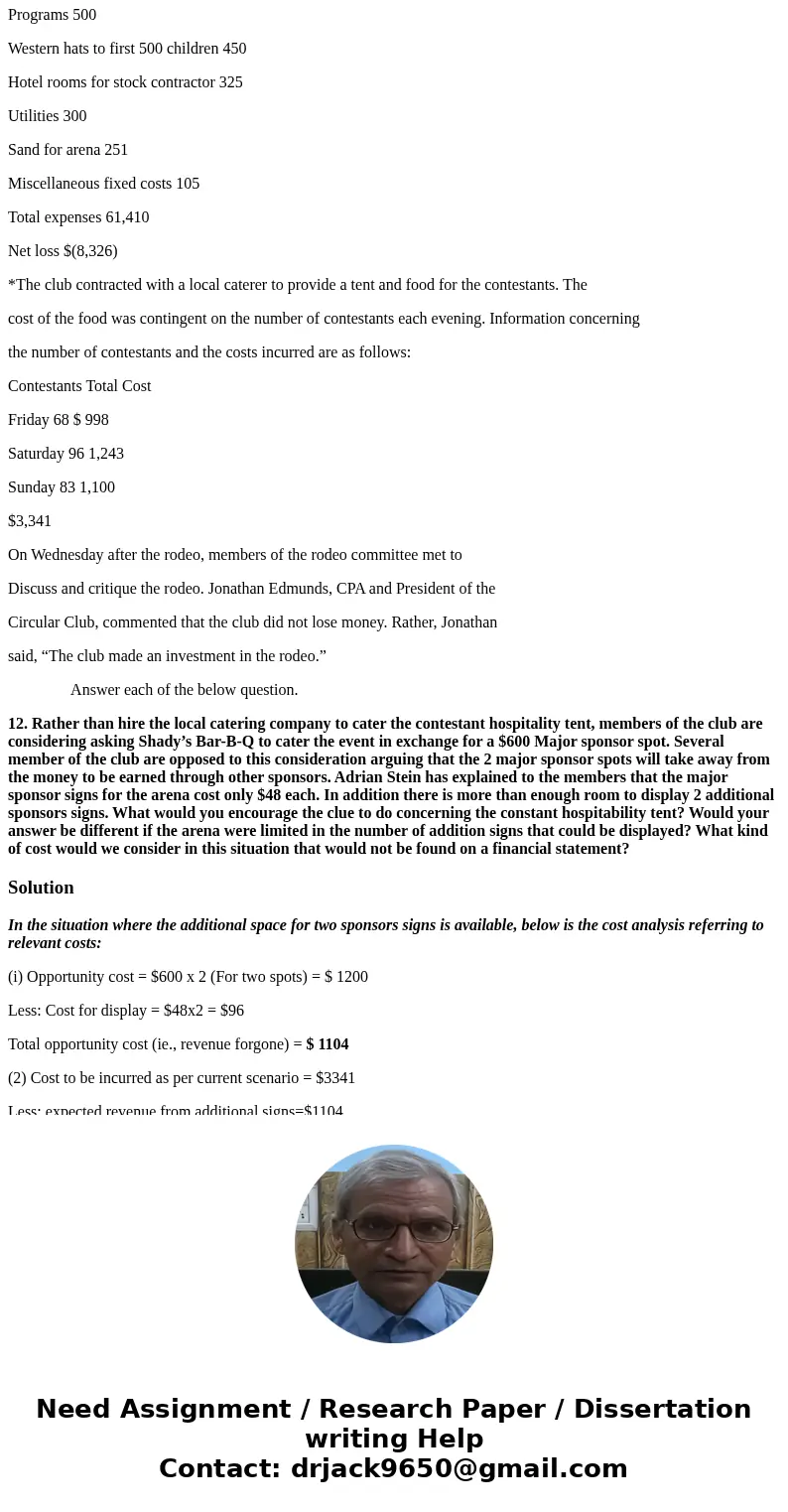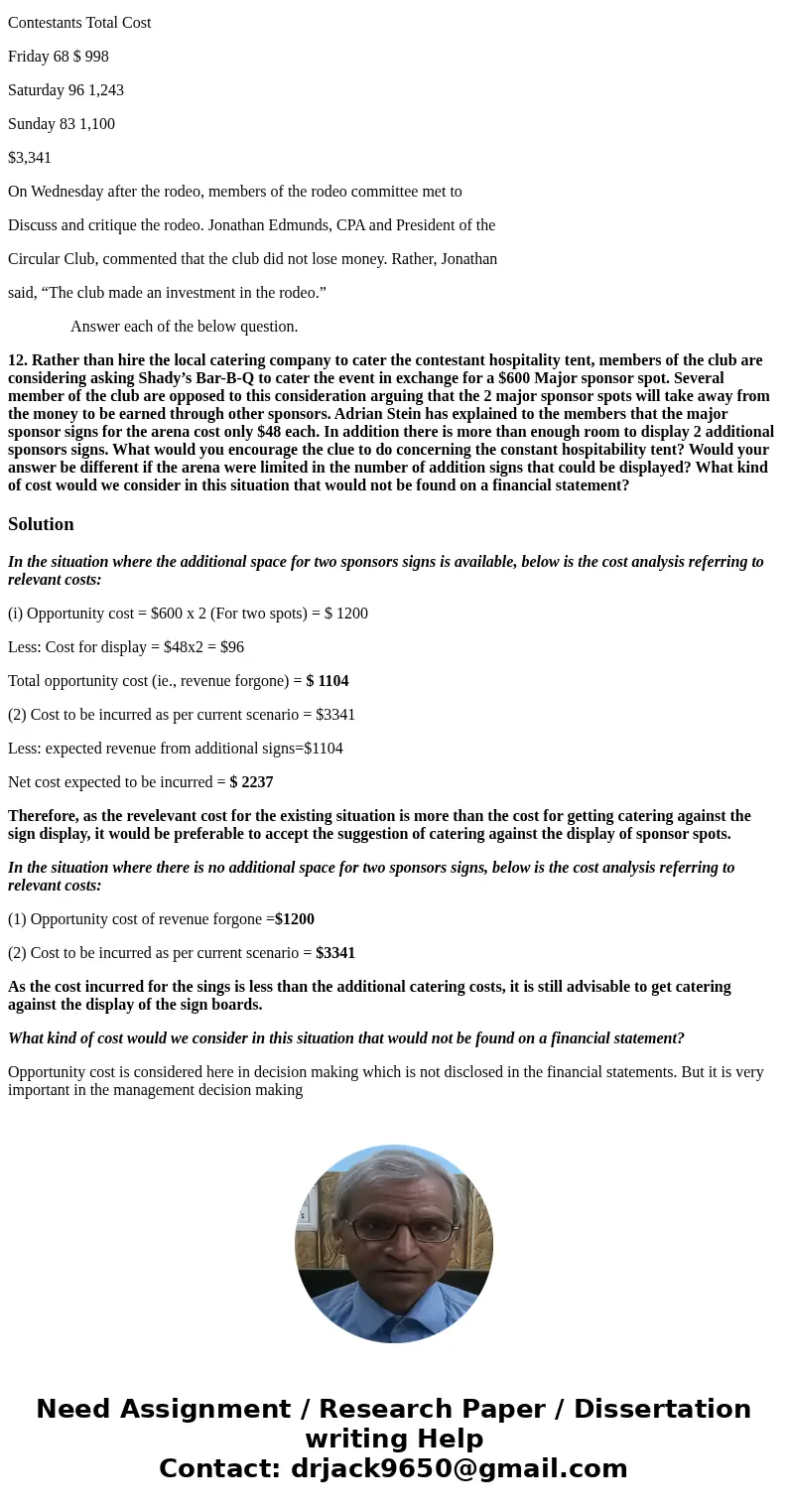THE BUSINESS SITUATION When Shelley Jones became presidentel
THE BUSINESS SITUATION
When Shelley Jones became president-elect of the Circular Club of Auburn, Kansas,
she was asked to suggest a new fundraising activity for the club. After a considerable
amount of research, Shelley proposed that the Circular Club sponsor a professional
rodeo. In her presentation to the club, Shelley said that she wanted a
fundraiser that would (1) continue to get better each year, (2) give back to the community,
and (3) provide the club a presence in the community. Shelley’s goal was to
have an activity that would become an “annual community event” and that would
break even the first year and raise $5,000 the following year. In addition, based on
the experience of other communities, Shelley believed that a rodeo could grow in
popularity so that the club would eventually earn an average of $20,000 annually.
A rodeo committee was formed. Shelley contacted the world’s oldest and
largest rodeo-sanctioning agency to apply to sponsor a professional rodeo. The
sanctioning agency requires a rodeo to consist of the following five events:
Bareback Riding, Bronco Riding, Steer Wrestling, Bull Riding, and Calf Roping.
Because there were a number of team ropers in the area and because they
wanted to include females in the competition, members of the rodeo committee
added Team Roping and Women’s Barrels. Prize money of $3,000 would be paid
to winners in each of the seven events.
Members of the rodeo committee contracted with RJ Cattle Company, a livestock
contractor on the rodeo circuit, to provide bucking stock, fencing, and
chutes. Realizing that costs associated with the rodeo were tremendous and that
ticket sales would probably not be sufficient to cover the costs, the rodeo committee
sent letters to local businesses soliciting contributions in exchange for
various sponsorships. Exhibiting Sponsors would contribute $1,000 to exhibit
their products or services, while Major Sponsors would contribute $600. Chute
Sponsors would contribute $500 to have the name of their business on one of the
six bucking chutes. For a contribution of $100, individuals would be included in
a Friends of Rodeo list found in the rodeo programs. At each performance the
rodeo announcer would repeatedly mention the names of the businesses and individuals
at each level of sponsorship. In addition, large signs and banners with
the names of the businesses of the Exhibiting Sponsors, Major Sponsors, and
Chute Sponsors were to be displayed prominently in the arena.
CaseA local youth group was contacted to provide concessions to the public and
divide the profits with the Circular Club. The Auburn Circular Club Pro Rodeo
Roundup would be held on June 1, 2, and 3. The cost of an adult ticket was set
at $8 in advance or $10 at the gate; the cost of a ticket for a child 12 or younger
was set at $6 in advance or $8 at the gate. Tickets were not date-specific. Rather,
one ticket would admit an individual to one performance of his or her choice—
Friday, Saturday, or Sunday. The rodeo committee was able to secure a location
through the county supervisors board at a nominal cost to the Circular Club. The
arrangement allowed the use of the county fair grounds and arena for a one week
period. Several months prior to the rodeo, members of the rodeo committee
had been assured that bleachers at the arena would hold 2,500 patrons. On
Saturday night, paid attendance was 1,663, but all seats were filled due to poor
gate controls. Attendance was 898 Friday and 769 on Sunday.
The following revenue and expense figures relate to the first year of the rodeo.
Receipts
Contributions from sponsors $22,000
Receipts from ticket sales 28,971
Share of concession profits 1,513
Sale of programs 600
Total receipts $53,084
Expenses
Livestock contractor 26,000
Prize money 21,000
Contestant hospitality 3,341*
Sponsor signs for arena 1,900
Insurance 1,800
Ticket printing 1,050
Sanctioning fees 925
Entertainment 859
Judging fees 750
Port-a-patties 716
Rent 600
Hay for horses 538
Programs 500
Western hats to first 500 children 450
Hotel rooms for stock contractor 325
Utilities 300
Sand for arena 251
Miscellaneous fixed costs 105
Total expenses 61,410
Net loss $(8,326)
*The club contracted with a local caterer to provide a tent and food for the contestants. The
cost of the food was contingent on the number of contestants each evening. Information concerning
the number of contestants and the costs incurred are as follows:
Contestants Total Cost
Friday 68 $ 998
Saturday 96 1,243
Sunday 83 1,100
$3,341
On Wednesday after the rodeo, members of the rodeo committee met to
Discuss and critique the rodeo. Jonathan Edmunds, CPA and President of the
Circular Club, commented that the club did not lose money. Rather, Jonathan
said, “The club made an investment in the rodeo.”
Answer each of the below question.
12. Rather than hire the local catering company to cater the contestant hospitality tent, members of the club are considering asking Shady’s Bar-B-Q to cater the event in exchange for a $600 Major sponsor spot. Several member of the club are opposed to this consideration arguing that the 2 major sponsor spots will take away from the money to be earned through other sponsors. Adrian Stein has explained to the members that the major sponsor signs for the arena cost only $48 each. In addition there is more than enough room to display 2 additional sponsors signs. What would you encourage the clue to do concerning the constant hospitability tent? Would your answer be different if the arena were limited in the number of addition signs that could be displayed? What kind of cost would we consider in this situation that would not be found on a financial statement?
Solution
In the situation where the additional space for two sponsors signs is available, below is the cost analysis referring to relevant costs:
(i) Opportunity cost = $600 x 2 (For two spots) = $ 1200
Less: Cost for display = $48x2 = $96
Total opportunity cost (ie., revenue forgone) = $ 1104
(2) Cost to be incurred as per current scenario = $3341
Less: expected revenue from additional signs=$1104
Net cost expected to be incurred = $ 2237
Therefore, as the revelevant cost for the existing situation is more than the cost for getting catering against the sign display, it would be preferable to accept the suggestion of catering against the display of sponsor spots.
In the situation where there is no additional space for two sponsors signs, below is the cost analysis referring to relevant costs:
(1) Opportunity cost of revenue forgone =$1200
(2) Cost to be incurred as per current scenario = $3341
As the cost incurred for the sings is less than the additional catering costs, it is still advisable to get catering against the display of the sign boards.
What kind of cost would we consider in this situation that would not be found on a financial statement?
Opportunity cost is considered here in decision making which is not disclosed in the financial statements. But it is very important in the management decision making




 Homework Sourse
Homework Sourse